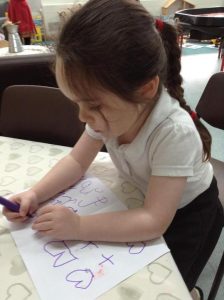- Our school
- Families
- Curriculum
- Current learning
- Latest
- Contact us
At Woodthorpe we tailor our writing curriculum to meet the needs of the children as they progress through the school, ensuring that areas of learning are taught at the appropriate points and that children are able to develop their basic skills with the overall aim of them becoming fluent, accurate writers by the time they leave the school.
In Nursery we follow the Development Matters document. We nurture children’s curiosity to mark make, explore tools and movements. We prepare children for the foundations of writing on a daily basis. In areas of provision, we provide plenty of opportunities for children to practice their fine motor and gross motor skills while teaching children the 5 key concepts of print.

Sentence writing uses phonics teaching as a basis for what the children write. The children write initial sounds or a dictated sentence including that day’s phonic sounds, up levelling their sentence if they are at that stage in their learning.
Handwriting is taught explicitly, introducing the children to correct pencil grip from the very beginning. The children focus on print in EYFS and then pre-cursive letters into year 1.
SPAG teaching focuses on both phonics for spelling and non-negotiables for punctuation and grammar.
We teach writing through an agreed writing structure that has been built upon some key principles We ensure that the teaching of writing revisits & models many of the skills that children need to be successful writers. We also use our writing curriculum to strengthen long-term recall and as a tool for children to engage in retrieval practice for topics that have been delivered some time in the past.
Our writing units always start with a ‘Connect’ phase. This ensures that children are able to revisit the ‘key knowledge’ from previous learning and so have the ‘discipline knowledge’ for the substance of their writing. Lessons then move through our learning cycle as teachers demonstrate (I Do), scaffold (We Do) and finally allow children the opportunity to independently write (You Do).
Our learning cycle starts:
Teachers expose children to an example of the writing genre to be covered, they will identify the key features and use their ‘writers voice’ to model how their writing has been constructed. Teachers will
In Reception & Year 1, spelling are linked to our phonics scheme and the current stage the pupils are within it.
In Year 2 – 6 we follow the ‘Spelling Shed’ spelling scheme. Children are taught a spelling rule/list within class and then practice the current set of spellings both in school and at home. Children who need extra support with spelling have personalised spellings for them to practise in class and are mainly linked to the 100 & 200 high frequency word lists.
Differing areas of punctuation and grammar are taught across a half term and teachers ensure that all areas of the curriculum are covered throughout the year. A termly SPAG assessment is completed to assess how children are progressing and teachers use these assessments to inform next steps in learning.
We use the scheme ‘Letter Join’ to teach handwriting throughout the school. From Nursery to Year 2, ‘Letter Join’ is followed exactly within weekly sessions. In Years 3 to 6 teachers adapt the scheme to meet the needs of their class.
Children initially learn print letter formations before moving onto pre-cursive and then cursive as they move through school.
To ensure that we have a good grasp on children’s learning, independent writing is marked against our ‘non-negotiables’. Teachers then use these assessments to plan next steps for pupils’ learning.
Our non-negotiables are at the heart of our curriculum ensuring there is a clear focus on the end of year expectations within every year group.
Year 2 loved meeting Ellie Hendry today who helped out with our rugby triathlon, all in aid of @OscarsCharity.
Thank you @YorkValkyrie and @YorkRLFC for coming to visit! #WPSYSport #WPSYY2
We had a brilliant day joining in for the rugby triathlon and raising money for a such an important charity 🏉 #WPSYSport
We are really proud of our Hockey team for their brilliant participation and teamwork in the tournament on Thursday. Well done everyone involved! 🏑 #WPSYSport #woodthorpecharacter
Reception had lots of fun today finding Easter pictures in our outdoor area. Some of them were really hard to find! Everyone got an Easter treat to say well done for finding them all! Happy Easter everyone! 🐥🐥🐥